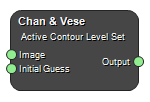Chan & Vese
Class: NodeChanVeseSegmentation

The Chan-Vese segmentation algorithm is designed to segment objects without clearly defined boundaries. This algorithm is based on level sets that are evolved iteratively to minimize an energy, which is defined by weighted values corresponding to the sum of differences intensity from the average value outside the segmented region, the sum of differences from the average value inside the segmented region, and a term which is dependent on the length of the boundary of the segmented region.
Typical values for \(\lambda_1\) and \(\lambda_2\) are 1. If the ‘background’ is very different from the segmented object in terms of distribution (for example, a uniform black image with figures of varying intensity), then these values should be different from each other.
This algorithm was first proposed by Tony Chan and Luminita Vese, in a publication entitled “An Active Contour Model Without Edges”, see 1.
Example Workflows
Chan Vese segmentation example
Inputs
Initial Level Set
The initial level set from which to start.
Type: Image4DFloat, Required, Single
Image
The image to be segmented.
Type: Image4DFloat, Required, Single
Outputs
Output
The segmented image.
Type: Image4DFloat
Settings
Area Weight Number
Area regularization values.
Curvature Weight Number
Scales all curvature weight values.
Epsilon Number
Width of regularization of Heaviside function.
Lambda 1 Number
Internal intensity difference weight.
Lambda 2 Number
External intensity difference weight.
Reinitialization Smoothing Weight Number
Weight of the laplacian smoothing term.
Volume Number
Volume.
Volume Matching Weight Number
Volume matching weight.
Use Image Spacing Boolean
Set whether or not the filter will use the spacing of the input image in its calculations.
Maximum RMS Error Number
Value of RMS change below which the filter should stop. This is a convergence criterion.
Iterations Integer
Set the number of iterations.
References
- “An active contour model without edges” T.Chan and L.Vese.In Scale - Space Theories in Computer Vision, pages 141 - 151, 1999.
- “Cell Tracking using Coupled Active Surfaces for Nuclei and Membranes” http://www.insight-journal.org/browse/publication/642 https://hdl.handle.net/10380/3055
- Chan Vese Segmentation in SimpleITK
See also
Keywords:
Copyright © 2022, NONPI Medical AB
